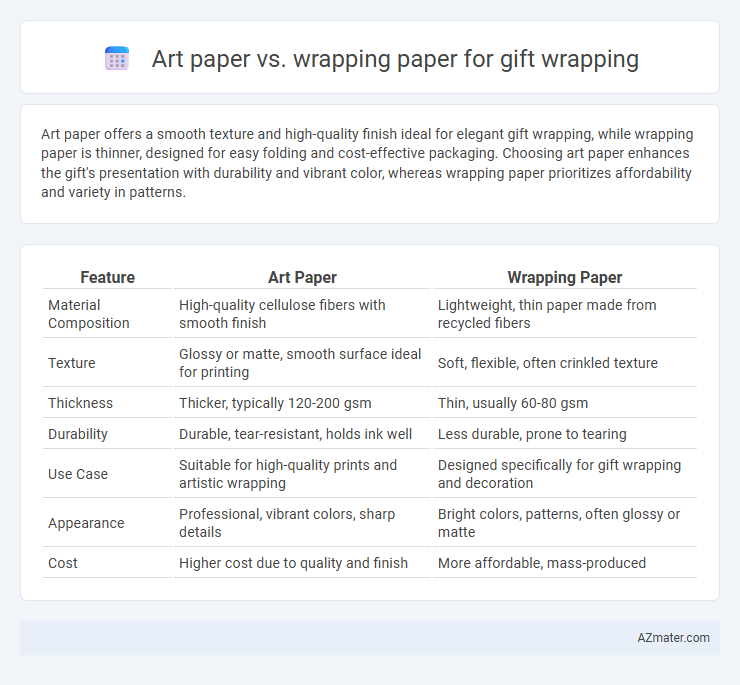Art paper offers a smooth texture and high-quality finish ideal for elegant gift wrapping, while wrapping paper is thinner, designed for easy folding and cost-effective packaging. Choosing art paper enhances the gift's presentation with durability and vibrant color, whereas wrapping paper prioritizes affordability and variety in patterns.
Table of Comparison
| Feature | Art Paper | Wrapping Paper |
|---|---|---|
| Material Composition | High-quality cellulose fibers with smooth finish | Lightweight, thin paper made from recycled fibers |
| Texture | Glossy or matte, smooth surface ideal for printing | Soft, flexible, often crinkled texture |
| Thickness | Thicker, typically 120-200 gsm | Thin, usually 60-80 gsm |
| Durability | Durable, tear-resistant, holds ink well | Less durable, prone to tearing |
| Use Case | Suitable for high-quality prints and artistic wrapping | Designed specifically for gift wrapping and decoration |
| Appearance | Professional, vibrant colors, sharp details | Bright colors, patterns, often glossy or matte |
| Cost | Higher cost due to quality and finish | More affordable, mass-produced |
Understanding Art Paper: Key Characteristics
Art paper features a smooth surface with a high-quality finish designed for superior print reproduction and vibrant color accuracy, making it ideal for professional artwork and detailed designs. Its durable composition resists tearing and creasing, providing a refined texture that enhances the aesthetic appeal of gift wrapping. Unlike wrapping paper, art paper often has a higher weight (measured in gsm) and a matte or gloss coating that contributes to its premium feel and longevity.
Wrapping Paper: Features and Varieties
Wrapping paper offers a diverse range of textures, patterns, and finishes specifically designed for gift wrapping, including glossy, matte, metallic, and textured varieties that enhance presentation. Its lightweight and flexible nature allows easy folding and shaping around gifts of various sizes, while tear-resistant options provide durability during handling. Specialty wrapping papers often incorporate eco-friendly materials, scented coatings, or customizable prints, catering to personalized and sustainable gift packaging needs.
Aesthetic Appeal: Comparing Visual Impact
Art paper offers a refined texture and vibrant color saturation that enhances the aesthetic appeal of gift wrapping, creating a visually striking presentation. Wrapping paper, designed specifically for gift packaging, often features patterned designs and glossy finishes that add festive charm and visual interest. Choosing art paper elevates the sophistication of the wrapped gift, while wrapping paper emphasizes decorative variety and holiday-themed appeal.
Durability and Strength: Which Lasts Longer?
Art paper, typically made from higher-quality fibers and designed for painting or drawing, offers superior durability and strength compared to wrapping paper, which is often thinner and more prone to tearing. Due to its thicker composition and sturdier texture, art paper withstands handling and environmental factors better, making it more suitable for long-term gift wrapping and preservation. Wrapping paper, while visually appealing, generally lacks the resilience of art paper and may not last as long when exposed to moisture or rough handling.
Eco-Friendliness: Sustainable Choices
Art paper and wrapping paper differ significantly in eco-friendliness, with art paper often made from recycled or sustainably sourced fibers, making it a more sustainable choice for gift wrapping. Many wrapping papers, especially those with glossy finishes or metallic decorations, contain plastics and non-recyclable elements that contribute to environmental waste. Choosing biodegradable art paper reduces landfill impact and supports circular economy practices in sustainable gift wrapping.
Cost Comparison: Budget Considerations
Art paper typically costs more than wrapping paper due to its higher quality, heavier weight, and smooth finish designed for professional art projects. Wrapping paper is generally more affordable and available in bulk, making it a budget-friendly option for frequent gift wrapping needs. Choosing wrapping paper over art paper reduces expenses significantly, especially for large quantities or casual gift wrapping.
Printing and Customization Options
Art paper offers superior printing quality with vibrant colors and sharp details, ideal for intricate designs and high-resolution images in gift wrapping. Wrapping paper typically uses lighter stock and standard printing methods, which limits customization options but allows for mass production with repetitive patterns. Customization on art paper supports advanced techniques like embossing, foil stamping, and personalized prints, making it the preferred choice for premium, unique gift presentations.
Texture and Finish: Tactile Differences
Art paper for gift wrapping offers a smooth, matte or glossy finish that provides a refined tactile experience, enhancing the elegance of the gift presentation. Wrapping paper typically has a thinner, more flexible texture with a slightly crinkly surface, designed for easy folding and durability during handling. The choice between art paper and wrapping paper significantly impacts the feel and perception of the wrapped gift, with art paper lending a premium, polished touch and wrapping paper emphasizing practicality and vibrant designs.
Suitability for Different Gift Types
Art paper offers a smooth, high-quality finish ideal for delicate or luxury gifts like jewelry or boutique items, enhancing presentation with elegance and durability. Wrapping paper, often made from thinner, more flexible materials, suits a wide variety of gifts including toys, clothing, and books, providing vibrant designs and easy folding. Choosing between art paper and wrapping paper depends on the gift's weight, shape, and occasion, with art paper reserved for premium presentation and wrapping paper for general use.
Final Recommendation: Which Paper Wins?
Art paper offers a smooth texture and superior durability, making it ideal for gift wrapping that requires a polished, professional appearance and long-lasting quality. Wrapping paper, while often more colorful and affordable, lacks the strength and premium finish found in art paper, which can lead to tearing or creasing during handling. For a refined and elegant gift presentation, art paper wins as the preferred choice due to its combination of aesthetics, resilience, and versatility.

Infographic: Art paper vs Wrapping paper for Gift wrapping
 azmater.com
azmater.com